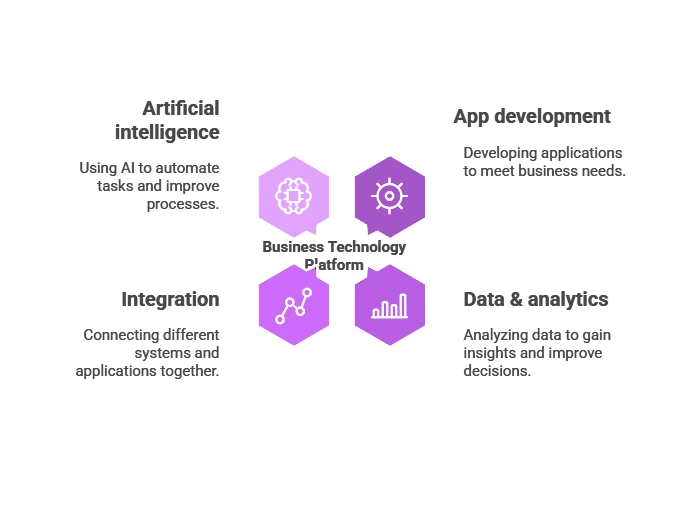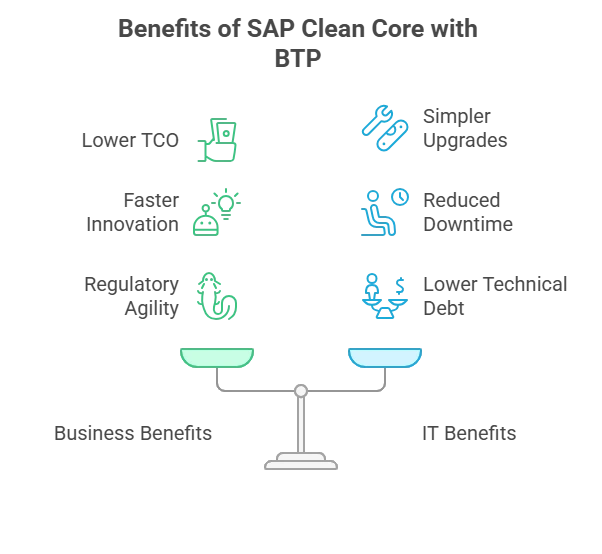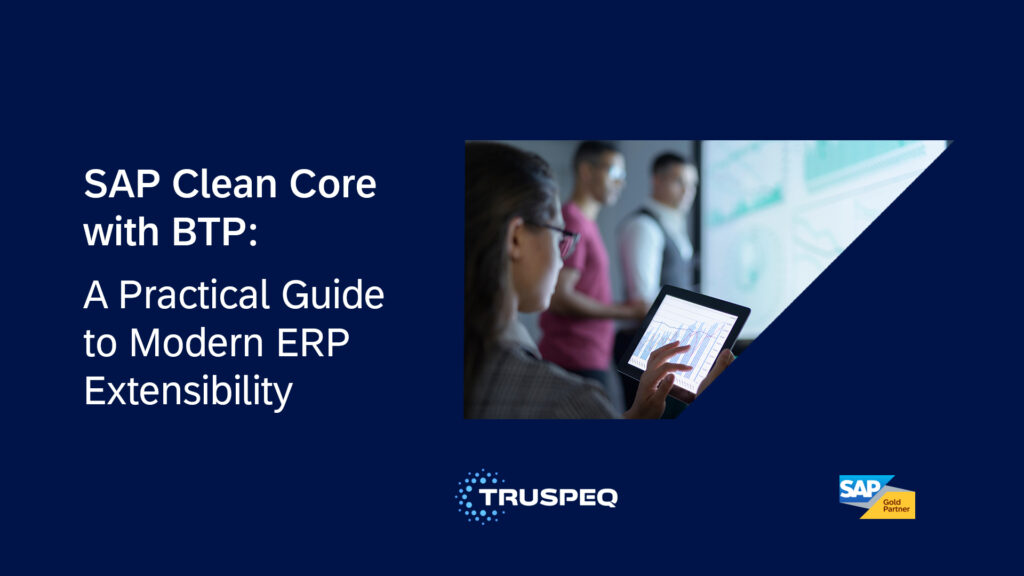What is this blog about?
This blog explores the concept of SAP Clean Core strategy and how SAP Business Technology Platform (BTP) enables modern ERP extensibility without compromising system stability. It explains Clean Core in simple terms, busts common myths, and provides a step-by-step guide to adopting Clean Core with SAP S/4HANA.
Who should read it?
Business leaders, CIOs, enterprise architects, IT managers, and SAP practitioners who are responsible for ERP modernization, digital transformation, and long-term SAP S/4HANA strategists will find this blog valuable.
Why is this important right now?
Enterprises today face increasing pressure to modernize their ERP systems as business needs evolve and cloud innovations accelerate. Heavy customizations can slow upgrades, increase costs, and create technical debt. Adopting a Clean Core ERP approach with SAP Business Technology Platform (BTP) provides the balance they need—keeping the core stable while enabling faster upgrades, lower costs, and future-proof extensibility.
What can you do with this insight?
You can start by auditing your ERP landscape to identify customizations, defining what belongs in the core vs. on BTP, and piloting one or two high-value BTP use cases. From there, establish governance to keep your ERP core clean while still innovating at the edges—ensuring your SAP S/4HANA system stays stable, modern, and ready for the future.
SAP Clean Core has become one of the most discussed strategies in the ERP world today—but to understand why, we need to look at the state of enterprise systems in 2025. ERP platforms remain the backbone of modern organizations, running finance, supply chain, HR, and customer operations. Yet most enterprises are weighed down by years of traditional ERP customization and technical debt.
Recent research highlights the scale of the challenge: “92% of organizations admit they are burdened with some form of technical debt, and 80% say this debt has forced them to delay or even cancel business-critical projects in the past year.(1)“ These numbers underline a clear reality—when ERP systems are over-customized, they not only become costly to maintain but also restrict innovation and slow down digital transformation.
This is why the industry is shifting toward strategies like SAP Clean Core with BTP. By keeping SAP S/4HANA lean and standardized while using SAP Business Technology Platform (BTP) for extensions and innovation, companies can finally balance ERP stability with the agility to evolve. In the next section, we’ll break down what “Clean Core” really means in simple terms—and why it’s central to modern ERP transformation.
Table of Contents
ToggleWhat Is Clean Core In Simple Terms?
At its heart, the Clean Core ERP approach is about keeping your SAP S/4HANA system as close to standard as possible. Think of your ERP as the engine of your business. If you constantly tinker with the engine—cutting wires, welding new parts, or modifying its inner mechanics—it might run today, but over time, it becomes harder (and riskier) to maintain. SAP Clean Core strategy is like keeping that engine intact, while making enhancements outside of it in a way that doesn’t damage the original design.
Instead of hardcoding changes directly into the ERP, you use SAP BTP integration as the “extension workshop” for building apps, automations, and analytics safely. This ensures your ERP remains upgrade-friendly, stable, and future-ready.
What is SAP Clean Core Strategy?
At its core, the SAP Clean Core strategy is a disciplined approach to keeping your SAP S/4HANA system clean, stable, and upgrade-ready while still allowing for innovation and flexibility through SAP BTP integration.
Unlike the old ERP model—where every business change meant hardcoding inside the ERP system—the Clean Core approach shifts customization and innovation outside the ERP engine. This ensures businesses can scale, innovate, and modernize without breaking the stability of their core system.
1. The Principles of Clean Core Strategy
- Keep the Core Standardized: SAP S/4HANA runs best when it stays close to standard. Clean Core means minimizing invasive custom code inside the ERP so upgrades and patches are seamless.
- Innovate Outside the Core: Use side-by-side extensibility on SAP BTP for apps, workflows, and integrations. This allows innovation without interfering with ERP stability.
- Balance Stability and Agility: The Clean Core strategy creates a foundation where ERP is stable for compliance and finance, while BTP enables agility for customer-facing and fast-changing business needs.
2. Common Myths about Clean Core
One misconception is that “Clean Core means no customization.” That’s not true. Businesses can (and should) customize—but the key is where and how. The SAP Clean Core implementation guide encourages using side-by-side extensions on BTP rather than embedding custom code in the ERP core.
Another myth is that Clean Core is only for companies already running fully in the cloud. In reality, SAP recommends even hybrid and on-premises SAP S/4HANA environments can start adopting a Clean Core strategy, gradually shifting customizations outward to SAP BTP use cases for extensibility.(2)
Role of SAP BTP in Clean Core Strategy
SAP BTP is the engine that brings the Clean Core ERP approach to life. Acting as the extension and innovation layer next to SAP S/4HANA, it gives organizations the flexibility to modernize without cluttering the ERP core. With capabilities like AI, app development, seamless integration, and data & analytics, BTP helps companies innovate faster, stay agile, and avoid the technical debt that comes with heavy in-core customizations.

How SAP BTP Supports Clean Core Strategy
- Side-by-Side Extensibility: Custom applications, workflows, and integrations are built on BTP, connected via APIs and events, keeping the ERP core clean and upgrades hassle-free.
- Seamless Integration: Pre-built connectors for SAP and non-SAP systems simplify integration across the enterprise, addressing one of the main challenges in ERP modernization.
- Innovation at Scale: Services such as AI, RPA, and advanced analytics allow organizations to deploy new processes and insights rapidly without waiting for ERP release cycles.
- Future-Ready Architecture: By separating stability (ERP core) from innovation (BTP), companies achieve a modern SAP ERP architecture that is agile, compliant, and cloud-ready.
By leveraging BTP in the Clean Core strategy, enterprises can maintain a standardized ERP while enabling innovation at the edges, balancing stability with agility in a sustainable way.
Benefits of SAP Clean Core with BTP
Adopting SAP Clean Core with BTP goes beyond maintaining a clean ERP core. By separating standardized processes in SAP S/4HANA from innovations on SAP BTP, organizations reduce risk while accelerating growth.
1. Business Benefits
- Lower Total Cost of Ownership (TCO): Keeping ERP standardized while running unique logic on BTP reduces upgrade and compliance costs.
- Faster Time-to-Innovation: Deploy new apps, AI-driven workflows, or dashboards in weeks, not months, without waiting for ERP upgrades.
- Regulatory Agility: Apply SAP-delivered compliance updates immediately, while BTP handles localized reporting and workflow rules.

2. IT Benefits
- Simpler Upgrades & Reduced Downtime: Side-by-side extensions on BTP keep ERP upgrades smooth and predictable.
- Lower Technical Debt: Offloading customizations to BTP prevents accumulation of in-core technical debt, freeing IT to focus on innovation.
- Future-Ready ERP Architecture: A modular, API-driven architecture enables integration with third-party systems, adoption of AI services, and scalable operations without jeopardizing ERP stability.
The benefits of SAP Clean Core with BTP are clear—lower costs, faster innovation, simplified IT, and a future-proof ERP foundation. By modernizing ERP with Clean Core and BTP, organizations balance stability and agility, ensuring their systems remain a platform for growth rather than a barrier.
Practical Use Cases Of SAP Clean Core With BTP
The real strength of SAP Clean Core with BTP is how it enables organizations to innovate without destabilizing the ERP core. Instead of embedding changes into SAP S/4HANA, extensions are built on BTP, connected through APIs and events. This model underpins a modern SAP ERP architecture where the ERP core stays clean and stable, while innovation happens side by side. Some practical use cases of SAP Clean Core with BTP include:
-
Smarter Finance with AI and Automation
With a Clean Core ERP approach, S/4HANA manages standard finance processes like general ledger and accounts payable, while SAP BTP enhances them with AI. Apps for invoice recognition, tax validation, or fraud detection run on BTP, reducing manual effort and errors—without touching the ERP core.
-
Supply Chain Visibility and Optimization
Instead of customizing ERP for IoT or partner data, companies connect these to BTP apps. Predictive analytics, shipment tracking, and demand forecasting become possible while keeping ERP upgrade-friendly. This separation lets supply chain teams adapt faster without adding technical debt.

-
Compliance and ESG Reporting
Regulatory and sustainability requirements change faster than ERP release cycles. SAP Clean Core with BTP keeps ERP standardized while extensions handle compliance automation and ESG dashboards. Businesses can deliver timely, audit-ready reports and adapt quickly to new regulations.
-
Enhanced Customer and Employee Experiences
Customer portals, mobile apps, and role-based tools are built on BTP, not inside S/4HANA workflows. ERP remains the system of record, while BTP delivers modern, mobile, and personalized experiences—improving customer satisfaction and employee productivity.
Real-World Scenario: Business & IT Benefits in Action
SAP BTP and AI-Powered Accelerators
We’ve developed a suite of intelligent accelerators on SAP Business Technology Platform (BTP), integrating automation, AI, and seamless connectivity to help enterprises modernize operations, enhance data-driven decision-making, and scale efficiently. These accelerators are particularly impactful for fintech and large enterprises managing complex, high-volume transactions.
1. AI-Enabled Mass Transaction Conversion Apps
Purpose-built applications to manage large-scale transaction conversions such as Journal Vouchers (JV), Goods Receipt Notes (GRN), Supplier Return Notes (SRN), and Invoices. Embedded AI models validate, classify, and detect anomalies in bulk data uploads—helping finance teams achieve speed, accuracy, and compliance at scale.
2. AI-Driven RPA Bots for Payment Clearing
Intelligent bots built using SAP Build Process Automation and AI-based matching logic to automate complex payment clearing activities, including partial clearings. These bots reduce manual reconciliation, improve accuracy, and accelerate closing cycles for finance operations.
3. Smart Integration Accelerators using SAP Integration Suite
Ready-to-deploy integration packages leveraging SAP Integration Suite and whitelisted APIs to connect SAP S/4HANA with external applications securely. These accelerators incorporate AI-based monitoring and exception prediction, ensuring faster implementation, improved resilience, and reduced maintenance effort.
4. Joule Activation for SAP Analytics Cloud (SAC)
We are actively deploying SAP Joule, the generative AI copilot for SAC, to empower business users with conversational analytics and predictive insights. Joule enables natural-language queries, trend analysis, and insight generation—helping decision-makers interpret data intuitively and drive strategic business actions.
The principle is clear:
- ERP Core = Stability and Compliance
- SAP BTP = Innovation and Extensibility
By separating stability from innovation, organizations can modernize SAP ERP with Clean Core and BTP, achieving reliability, agility, and continuous transformation.
How To Implement SAP Clean Core With BTP: A Practical Roadmap
Adopting a Clean Core ERP approach with SAP BTP is a structured transformation journey, not a one-time switch. Think of it like renovating a house: modernize step by step while keeping the foundation strong.

-
Assess Your ERP Landscape
The first step is visibility. Over time, SAP S/4HANA systems build up layers of custom code—some still critical, much of it outdated. Tools such as SAP Custom Code Analyzer, ABAP Test Cockpit (ATC), and SAP Readiness Check can help sort what’s valuable from what’s driving up costs or blocking upgrades.
Integration is another area to tackle early. If your landscape is still dependent on point-to-point connections, upgrades will continue to be painful. Moving to API-first, event-driven integrations on SAP BTP makes your architecture far more resilient and scalable.
-
Define Your Clean Core Strategy
Once you know what you’re working with, set the rules of the game. Decide what belongs in ERP and what should shift to BTP.
- From a business perspective: Where is agility needed most—finance automation, compliance, supply chain, or customer engagement?
- From an IT perspective: Adopt a “no new in-core customizations unless absolutely necessary” policy and embrace fit-to-standard practices.
A simple guiding principle helps: ERP is for standardized processes; BTP is for differentiation and innovation. Without this clarity, it’s easy to fall back into old habits that clutter the core again.
-
Prioritize High-Value Use Cases
Don’t try to move everything at once. Start with use cases that can deliver fast, visible value:
- AI-driven invoice automation on BTP
- Real-time supply chain dashboards
- Streamlined compliance and reporting
These early wins reduce cost, accelerate processes, mitigate risks, and help secure both executive and IT buy-in. They also build confidence across the organization to expand Clean Core adoption further.
-
Shift Extensions to BTP and Keep the Core Clean
This is where execution takes shape. Instead of embedding custom logic into ERP, use SAP BTP Extension Suite and Integration Suite to run side-by-side applications.
- Example: Run country-specific tax calculations on BTP instead of modifying ERP.
- Lightweight in-app changes (like SAP Fiori key user extensibility) are fine, but heavier innovation should move to BTP for flexibility and future-proofing.
This approach ensures the ERP remains stable and upgrade-ready while innovation happens safely on the side.
-
Establish Ongoing Governance and Monitoring
Clean Core isn’t a one-off project—it’s an operating model. Sustaining it requires governance:
- Track KPIs such as upgrade cycle times, reduction in in-core customizations, and ROI from BTP extensions.
- Use tools like SAP Cloud ALM, Solution Manager, and Change Impact Analysis to monitor progress.
- Many organizations also establish a Clean Core Center of Excellence (CoE) to evaluate new requirements and ensure alignment with strategy.
Without governance, the ERP core risks getting “dirty” again—undoing the benefits of modernization.
Conclusion: Why SAP Clean Core With BTP Is The Future Of ERP Extensibility
The growing adoption of a Clean Core ERP approach reflects a clear reality: enterprises can no longer afford rigid, heavily customized ERP systems. Business leaders need faster innovation, while IT leaders demand predictable upgrades and reduced technical debt.
For many organizations that have already begun evaluating system modernization paths through a SAP ERP Comparison, this shift becomes even more obvious. SAP Clean Core with BTP, thus, provides the balance. By keeping SAP S/4HANA lean and standardized, and using SAP BTP integration for extensions and innovation, companies can achieve both stability in the core and agility at the edges. This model represents the foundation of a modern SAP ERP architecture.
Research underscores the value of this approach. For example, Deloitte’s Tech Trends 2024 report notes that organizations actively managing technical debt through modernization can deliver technology services up to 50% faster. This aligns directly with the benefits of a SAP Clean Core strategy, where standardization reduces ERP complexity and BTP enables continuous innovation without risking stability.(3)
Looking ahead, those organizations will thrive that treat ERP not as a monolith, but as a platform for continuous extensibility. With SAP Clean Core in S/4HANA supported by BTP, businesses can modernize processes, embed AI and automation, and stay compliant with evolving regulations—all while keeping ERP performance intact.
Modernizing SAP ERP with Clean Core and BTP is not just a technical exercise—it’s a strategic move toward long-term agility. For business and IT leaders in 2025, the real question is no longer “Should we adopt Clean Core?” but “How quickly can we make it happen?”
Explore our SAP Implementation Services, SAP Managed Services, and SAP S/4HANA Migration Solutions for tailored guidance.
Talk to our SAP consultants today.
FAQs:
What does SAP Clean Core mean in simple terms?
SAP Clean Core is about keeping the ERP core (SAP S/4HANA) as close to standard as possible—no heavy custom code inside—while moving customizations, extensions, and innovations to SAP BTP. This ensures the ERP remains stable and easy to upgrade, while still allowing business-specific flexibility.
How does SAP BTP support the Clean Core strategy?
SAP BTP acts as the extension and innovation layer. It enables custom app development, workflow automation, AI/ML services, and integrations with other systems—without modifying the ERP core. This balance gives companies agility and future-proof ERP extensibility.
Is Clean Core only relevant for cloud ERP customers?
No. While Clean Core aligns naturally with cloud ERP, hybrid and even on-premises S/4HANA systems can adopt it by moving extensions and integrations onto BTP. It’s a strategy for any ERP landscape looking to reduce technical debt and simplify upgrades.
What are the main benefits of adopting SAP Clean Core with BTP?
Key benefits include:
- Faster and smoother SAP S/4HANA upgrades
- Reduced costs from lower maintenance and less technical debt
- Ability to innovate continuously without disrupting ERP stability
- Easier compliance with SAP’s future roadmap
Where should organizations start with Clean Core?
You can start by auditing your ERP customizations, deciding what belongs in the core vs. BTP, and piloting one or two high-value BTP use cases (e.g., AI in finance, ESG reporting). From there, establish governance so your ERP stays clean while innovation scales on BTP.
Authors
-

Abhijeet has nearly two decades of experience in driving sales and marketing strategies around SAP-led digital transformation, helping clients align technology investments with measurable business outcomes. He has worked closely with enterprises across industries to position SAP S/4HANA, RISE with SAP, and cloud solutions as enablers of growth, agility, and efficiency. His expertise lies in combining solution knowledge with a consultative approach, ensuring customers see both the business value and the roadmap to adoption. Abhijeet holds an engineering degree from Government College of Engineering, Pune.
-

Abhishek is a seasoned SAP solutioning and presales expert with extensive experience in shaping enterprise transformation strategies. As the former Customer Advisory Lead at SAP, he has guided CXOs and business leaders on adopting SAP S/4HANA, RISE with SAP, and cloud innovations to maximize business value. He is a certified SAP consultant and has led SAP Centers of Excellence for large multinationals, bringing deep expertise in designing scalable architectures and driving adoption. Abhishek holds an engineering degree and combines hands-on consulting experience with strong advisory skills to help enterprises realize the vision of the intelligent enterprise.



